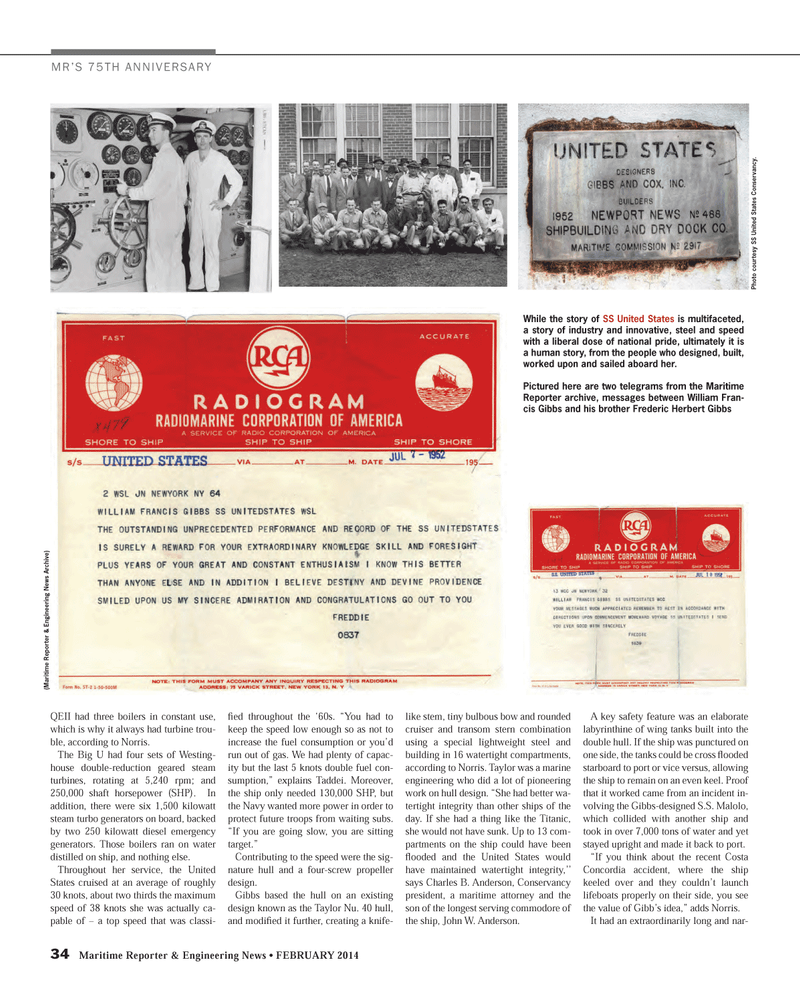
Page 34: of Maritime Reporter Magazine (February 2014)
Cruise Shipping Edition
Read this page in Pdf, Flash or Html5 edition of February 2014 Maritime Reporter Magazine
34 Maritime Reporter & Engineering News • FEBRUARY 2014
MR’S 75TH ANNIVERSARY
QEII had three boilers in constant use, which is why it always had turbine trou- ble, according to Norris.
The Big U had four sets of Westing- house double-reduction geared steam turbines, rotating at 5,240 rpm; and 250,000 shaft horsepower (SHP). In addition, there were six 1,500 kilowatt steam turbo generators on board, backed by two 250 kilowatt diesel emergency generators. Those boilers ran on water distilled on ship, and nothing else.
Throughout her service, the United
States cruised at an average of roughly 30 knots, about two thirds the maximum speed of 38 knots she was actually ca- pable of – a top speed that was classi- fi ed throughout the ‘60s. “You had to keep the speed low enough so as not to increase the fuel consumption or you’d run out of gas. We had plenty of capac- ity but the last 5 knots double fuel con- sumption,” explains Taddei. Moreover, the ship only needed 130,000 SHP, but the Navy wanted more power in order to protect future troops from waiting subs. “If you are going slow, you are sitting target.”
Contributing to the speed were the sig- nature hull and a four-screw propeller design.
Gibbs based the hull on an existing design known as the Taylor Nu. 40 hull, and modifi ed it further, creating a knife- like stem, tiny bulbous bow and rounded cruiser and transom stern combination using a special lightweight steel and building in 16 watertight compartments, according to Norris. Taylor was a marine engineering who did a lot of pioneering work on hull design. “She had better wa- tertight integrity than other ships of the day. If she had a thing like the Titanic, she would not have sunk. Up to 13 com- partments on the ship could have been fl ooded and the United States would have maintained watertight integrity,’’ says Charles B. Anderson, Conservancy president, a maritime attorney and the son of the longest serving commodore of the ship, John W. Anderson.
A key safety feature was an elaborate labyrinthine of wing tanks built into the double hull. If the ship was punctured on one side, the tanks could be cross fl ooded starboard to port or vice versus, allowing the ship to remain on an even keel. Proof that it worked came from an incident in- volving the Gibbs-designed S.S. Malolo, which collided with another ship and took in over 7,000 tons of water and yet stayed upright and made it back to port. “If you think about the recent Costa
Concordia accident, where the ship keeled over and they couldn’t launch lifeboats properly on their side, you see the value of Gibb’s idea,” adds Norris.
It had an extraordinarily long and nar-
While the story of SS United States is multifaceted, a story of industry and innovative, steel and speed with a liberal dose of national pride, ultimately it is a human story, from the people who designed, built, worked upon and sailed aboard her.
Pictured here are two telegrams from the Maritime
Reporter archive, messages between William Fran- cis Gibbs and his brother Frederic Herbert Gibbs (Maritime Repor ter & Engineering News Ar chive)
Photo cour tesy SS United States Conser vancy .
MR #2 (32-41).indd 34 2/3/2014 10:24:21 AM

 33
33

 35
35
